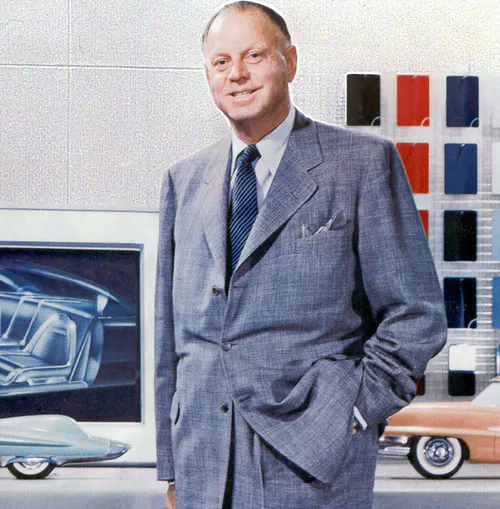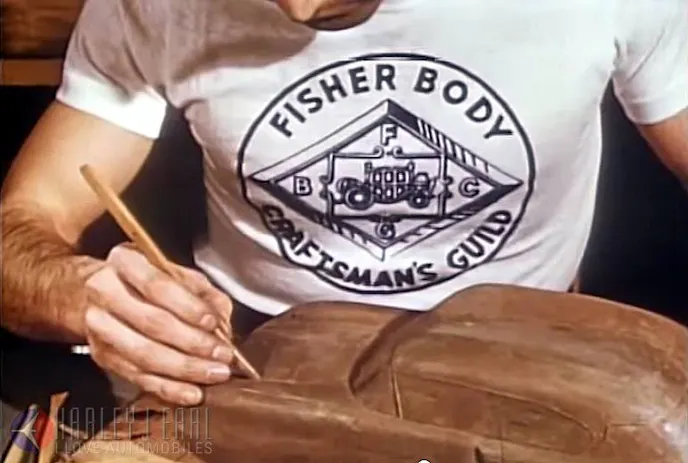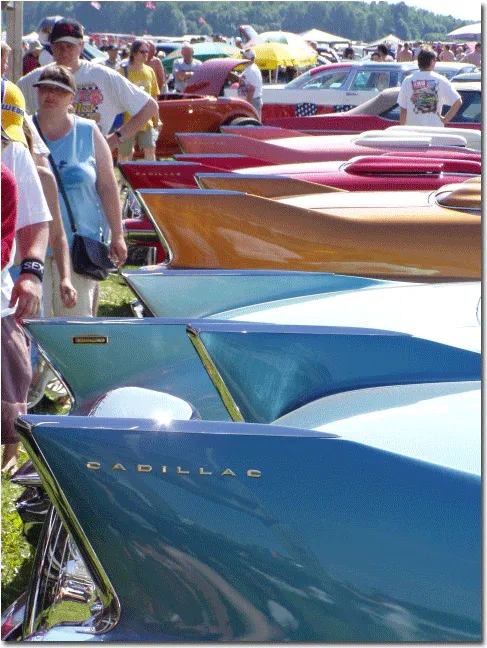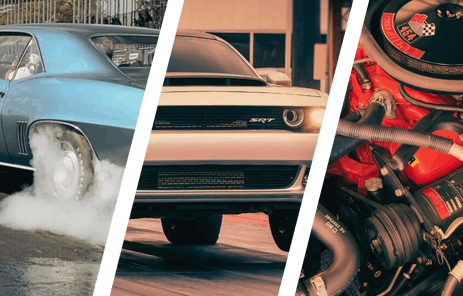 You may not have heard of Harley J. Earl but unless you’ve been living under a very heavy rock your entire life, you have seen tailfins on a vintage car and know what a Corvette is. Those are some of the more popular embodiments of a lasting legacy Harley J. Earl created. These and many other visions are ways that the “Father of Car Design” flipped the automotive world upside down, changing the landscape of automotive design forever.
You may not have heard of Harley J. Earl but unless you’ve been living under a very heavy rock your entire life, you have seen tailfins on a vintage car and know what a Corvette is. Those are some of the more popular embodiments of a lasting legacy Harley J. Earl created. These and many other visions are ways that the “Father of Car Design” flipped the automotive world upside down, changing the landscape of automotive design forever.

Harley J. Earl was an industrial designer that focused on automobiles. He was the very first Head of Design for General Motors and then became Vice President making him the first top executive ever designated specifically for product design for a large scale American company. Looking at his history, it seems it was always meant to be.
Born the son of a coachbuilder in the late 1800s, Earl was immediately thrown into the life of vehicles and transportation. His father, J.W. Earl owned and operated Earl Carriage Works in Los Angeles, California, which he officially changed to Earl Automobile Works in the first decade of the 1900s. The senior Earl had switched his company over from building and maintaining horse-drawn carriages to the budding world of automobiles because of the grip automobiles took on the region, and the world.
At a young age, Harley J. Earl (HJE) started building vehicles. The first of which were small handmade box carts that kids would race down the hills in Hollywood. HJE’s coasting carts were often better built, safer and faster than all the others. Around 1909, HJE and his older brother, Art Earl, happened upon a large patch of clay on the family property.
Harley started designing cars out of clay way back then, clay that he took out of the ground. –Art EarlIn a 1980 interview Art described the scene, “Harley started designing cars out of clay way back then, clay that he took out of the ground.” He continued, “He’d pick up a big chunk of clay and would work it down to the sort of car he wanted. I guess we had twenty or thirty of these little cars of different shapes; roadsters and touring cars. And, we had a lot of fun.” HJE’s father even remarked, “These models, some were damn near full-size, were not like cars of the day, but as they might be later in the future. It was really kind of eerie seeing all these rounded off car bodies in a period when automobiles were mainly just boxes on wheels.” Automobiles at that time were designed around functionality.
Designed by traditional engineers and centered around cost, they would tend to lack the imagination HJE wanted from them.
HJE went on to study engineering and art simultaneously at Stanford University. His father continued to grow Earl Automobile Works by becoming the first to make and market custom automobile bodies and accessories, effectively creating the automotive aftermarket. Straight across the street from Earl Automobile Works is Don Lee Cadillac, the region’s Cadillac dealer. This important tidbit would come back up as the years ticked on.
From Hollywood Contracts To Harley J. Earl’s Rise Within GM
These models, some were damn near full-size, were not like cars of the day, but as they might be later in the future. It was really kind of eerie seeing all these rounded off car bodies in a period when automobiles were mainly just boxes on wheels. –J.W. EarlJ.W. Earl’s company grew to be the largest automotive plant on the West Coast; specializing in custom bodies. J.W. landed automotive contracts with several movie studios. The area around Earl Automobile Works and Don Lee Cadillac became known as “Auto Row” and this area would go on to shape southern California’s massive movement in the transportation world. HJE joined in and began utilizing his artistic nature and engineering skills together, making his talents highly valued.
His custom designed cars caught the attention Hollywood’s celebrities. Silent film actors Tom Mix and Rosco (Fatty) Arbuckle commissioned HJE for custom orders, just so they could keep up with the others in the business. Arbuckle’s custom creation is considered one of the most over the top celebrity customs ever. HJE went on to file for a couple of United States patents. By the time he passed away, Harley Earl had more than 20 US patents in his name. His patent drawings are incredible pieces of artwork all on their own.
The biggest rival for Earl Automobile Works most certainly took notice. Don Lee Cadillac purchased Earl Automobile Works the same year the LA Times reported that Don Lee had sold his 10,000th Cadillac since he started selling them fourteen years prior. Many speculate this was strictly just a ploy to bring HJE under his employment. Regardless of the reasoning, this next step in HJE’s career was a hefty leap. Don Lee and HJE would go on to produce over 1,000 custom vehicles.
As a member of the elite Los Angeles Country Club in Beverly Hills, HJE was rubbing elbows with other legends in the making. HJE knew what Detroit and Henry Ford were doing wrong with the mass produced automobile. “The cars I design for movie stars and millionaires,” explains HJE to the Fisher brothers, “ I can have coming off all of GM’s assembly lines in the future.” The Fisher brothers had ties deep into General Motors; HJE was soon consulting directly to them and was included in a group that was working on new concepts for a car line that would be a “companion car” to the Cadillac.
 After HJE was officially hired by Cadillac as a consulting engineer, his gloves came off. He started working diligently on a new concept that he pitched to the Fisher brothers, still the largest shareholding family of GM at the time. Earl kept a tight lip on his plans as he wanted nothing to do with Ford or Chrysler.
After HJE was officially hired by Cadillac as a consulting engineer, his gloves came off. He started working diligently on a new concept that he pitched to the Fisher brothers, still the largest shareholding family of GM at the time. Earl kept a tight lip on his plans as he wanted nothing to do with Ford or Chrysler.
In 1927, HJE’s first concept car was being realized. The LaSalle was designed to push the boundaries of automotive style. Meant to be a smaller and more agile auto when compared to a Cadillac, the LaSalle was given a Cadillac V8, making it much sportier than its heavier relative. The LaSalle set the stage for the reinvention of the automobile market. “From this point forward, Harley J. Earl had become the American auto industry’s first industrial designer.” says Richard Earl, Harley’s grandson.
 With this incredible leap forward in automobile design for GM, the rest of the world took notice. “Car Design Secrecy” became a common practice for all auto manufacturers, increasing the lengths competitors would go to steal ideas and concepts. At this time, engineers within GM were struggling to get a grasp on the forward thinking and pre-designing going on in Earl’s new Art and Colour Section.
With this incredible leap forward in automobile design for GM, the rest of the world took notice. “Car Design Secrecy” became a common practice for all auto manufacturers, increasing the lengths competitors would go to steal ideas and concepts. At this time, engineers within GM were struggling to get a grasp on the forward thinking and pre-designing going on in Earl’s new Art and Colour Section.
In 1930, HJE and Larry Fisher dropped a bomb on the American automotive market by introducing their super car. The 1930 Cadillac V16 was built in secret and when released set a new standard for luxury and performance. This was a spring board for GM to take around 40% of the new automobile market share. One of the many patents HJE had was a design patent for the original V16 Cadillac.
Into the 30s, HJE continued to wow GM and the public. Cadillac asked him to build a special vehicle for them to showcase at the General Motors pavilion at the Century of Progress Exhibition at the 1933 World’s Fair held in Chicago. The Cadillac Aero-Dynamic Coupe was like nothing else the world had ever seen. Several innovations were scattered throughout the entire car, one of which was the one-piece and all-steel roof that would later lead into the Turret-Top.

In 1938, HJE developed the Buick Y-Job. The one-off custom Buick started the concept car trend and was also Earl’s personal vehicle, racking up around 50,000 miles. Soon after, Buick adopted Earl’s turn signal innovations making it the first manufacturer to install turn signals from the factory. A year after that, the turn signals were added to the front and added a self-cancelling system for after the turn had been made. GM began loosening the stones below Ford’s number 1 position. During World War II, GM played a major role in aiding the United States military. The advanced engineering taking place within the GM walls was an edge to be used in the war design efforts.
The GM Futureliner was a large custom truck designed by Earl specifically for the Parade of Progress that GM touted around North America in 1940 and 1941 and then again from 1953 to 1956. These behemoth vehicles carried relevant innovations in advancing technologies such as jet engines, televisions and microwave ovens.
Harley J. Earl’s Everlasting Legacy – Tailfins, Motoramas, And Modern Artists

Drawn to styling of modern aircraft, HJE enjoyed incorporating design ideas into his own designs. The automotive tailfin has a direct relation to airplane tailfins. Together with Bill Mitchell, Franklin Q. Hershey and Art Ross, HJE designed the 1948 Cadillac to be very much like the then secret Lockheed P-38 “Lightning” aircraft. This was the first usage of an automotive tailfin in production.
The Le Sabre concept is a prime example of how styling cues can enter the mainstream. Designed to resemble a jet fighter, the Le Sabre had bumper bullets, heated seats and a 12-volt electrical system that would later be adopted all around the industry. Earl drove the car daily for two years as a show of reliability and roadworthiness.
Harley J. Earl’s dream car came to fruition in 1953 with the Corvette, originally codenamed “Project Opel.” 300 fiber-glassed Corvettes were built, many of which were given away to celebrities. In an interview with local Detroit writer Stan Brams, HJE explains how he thought of the idea to build the first American sportscar, “I ran that Le Sabre up pacing a race, […] a sports car race at Watkins Glen, that’s where I got the idea for the Corvette.” Industry reporters refer to GM’s auto designers as “Harley Earlites.” The auto industry buzzed with all things Harley J. Earl. The phrase “Our Father Who Art in Styling, Harley Earl Be Thy Name,” was commonly shared.
“Inside the inner sanctum of his design organization within the new tech center,” Richard Earl explains, “HJE has his team build a custom racing Corvette for his son, Jerry, to take on the US racing circuit. It is named the Corvette SR-2. Harley appoints a team of GM styling members to assist in his son’s racing efforts. Like most things HJE does, this one in particular creates enormous tension inside the corporation since all the other [department heads] have to stand by and watch this man get to build an expensive sports car for his son inside the company with GM’s money.”

Harley J. Earl created a sector of the automotive industry that hadn’t stood on its own before. He retired in 1958 and knew he was personally responsible for changing the way we all look at a car.
Harley J. Earl died on April 10th, 1969 and The Detroit News headline read: “Death of the one-and-only: CAR DESIGN PIONEER.” Ward’s AutoWorld went on to feature an extensive cover story titled “Harley J. Earl: The Man Who Invented The Modern Car.”
Harley J. Earl had a massive impact on future generations of car designers and enthusiasts. His design principles, concepts and visions have touched many lives in different ways. Steve Stanford is an amazingly talented automotive artist that directly attributes Harley J. Earl to being an inspiration and hero. In a quick interview with Stanford, he explains, “I have always been partial to GM products, even though I like everything.” He continues, “I was just drawn to them. I realized later that [HJE] was responsible for those designs.” Stanford believes that not enough people know of HJE or know the impact he has had on automobile design. The pure unfettered imagination of Harley J. Earl is what drew and continues to draw Steve Stanford to his artistic works.
Appearance and function are of parallel importance. –Harley J. EarlGM’s famed Motorama was the brain child of Harley J. Earl. The parade of a new model or model change on an annual basis was initiated by HJE. “Back in the parade days of the 50s and 60s inside GM,” says Bob Lutz, former Vice Chairman of Global Product Development for GM, “Design ruled and everything else followed.” HJE effectively created “Planned Obsolescence.” Annual style changes were about refreshing the designs and keeping them continually new-ish if not completely new. HJE had a timeless motto that spans beyond the automotive industry and accurately describes the world we live in today, “Appearance and function are of parallel importance.”
For more on Harley J. Earl, head over to the official website www.harleyjearl.com.
You might also like
SEMA 2025: Superformance Godzilla Cobra Snake Packs 1,000 HP
The Godzilla Cobra is a 1,000hp tribute to Carroll Shelby. Superformance's new CSX10000 features a supercharged 7.3L V8.





